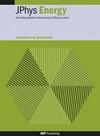High performance composite Pr4Ni3O 10±δ —Ce0.75Gd0.1Pr0.15O 2−δ solid oxide cell air electrode
IF 6.3
3区 材料科学
Q1 ENERGY & FUELS
引用次数: 0
Abstract
A composite electrode composed of Pr4Ni3O 10±δ —Ce0.75Gd0.1Pr0.15O 2−δ (50 wt.%–50 wt.%) was thoroughly investigated in terms of the electrochemical performance as a function of microstructure. The electrochemical performance was characterized by electrochemical impedance spectroscopy and the microstructures, characterized by focused ion beam-scanning electron microscopy and 3D reconstructions, were modified by changing the particle size of Pr4Ni3O 10±δ and the electrode thickness. The distribution of relaxation time method was applied to help resolve electrochemical processes occurring in the electrodes. It was found that an appropriate increase in electrode thickness and an appropriate decrease in particle size enhanced the oxygen reduction reaction (ORR) kinetics. The lowest area specific resistance obtained in this study at 670 ∘C under pO 2 of 0.21 atm was 0.055 Ω cm2. Finally, a comparison to the Adler-Lane-Steele (ALS) model was made and the main active site for the ORR was concluded to be triple phase boundaries. A fuel cell made of the composite material as the cathode was fabricated and tested. The peak power density was 1 W cm−2 at 800 ∘C, which demonstrates that this composite material is promising for solid oxide fuel cell cathodes.高性能复合pr4ni30o 10±δ -Ce0.75Gd0.1Pr0.15O 2−δ固体氧化物电池空气电极
研究了由pr4ni30o 10±δ - ce0.75 gd0.1 pr0.15 o2−δ (50 wt.% -50 wt.%)组成的复合电极的电化学性能与微观结构的关系。通过电化学阻抗谱对其电化学性能进行表征,通过聚焦离子束扫描电镜和三维重建对其微观结构进行表征,通过改变pr4ni30o 10±δ的粒径和电极厚度来改变其微观结构。利用弛豫时间分布法分析了电极中发生的电化学过程。研究发现,适当增加电极厚度和适当减小电极粒径可提高氧还原反应动力学。在本研究中,在0.21大气压下,在670°C下获得的最小面积比电阻为0.055 Ω cm2。最后与Adler-Lane-Steele (ALS)模型进行了比较,得出ORR的主要活性位点为三相边界。制备了以该复合材料为阴极的燃料电池并进行了试验。在800°C时的峰值功率密度为1 W cm−2,这表明这种复合材料很有希望用作固体氧化物燃料电池的阴极。
本文章由计算机程序翻译,如有差异,请以英文原文为准。
求助全文
约1分钟内获得全文
求助全文
来源期刊

Journal of Physics-Energy
Multiple-
CiteScore
10.90
自引率
1.40%
发文量
58
期刊介绍:
The Journal of Physics-Energy is an interdisciplinary and fully open-access publication dedicated to setting the agenda for the identification and dissemination of the most exciting and significant advancements in all realms of energy-related research. Committed to the principles of open science, JPhys Energy is designed to maximize the exchange of knowledge between both established and emerging communities, thereby fostering a collaborative and inclusive environment for the advancement of energy research.
 求助内容:
求助内容: 应助结果提醒方式:
应助结果提醒方式:


